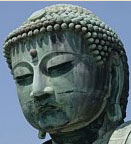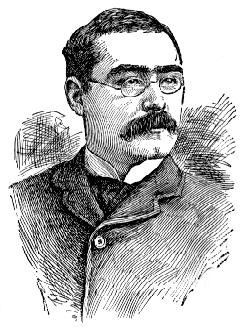The Buddha at Kamakura
by Rudyard Kipling
Big Buddha in Kamakura
Constructed in 1252. Of the three giant effigies of Buddha in Japan, it alone remains in orginal form, whereas the 8th-century 72-feet-high statue in Nara was recast, and the famous 160-feet-high Kyoto Daibutsu was entirely destroyed and replaced by a small wooden substitute.
Located at Koutokuin 高徳院 in Kamakura, the Kamakura Daibutsu (literally “Kamakura Big Buddha”) is a giant metal statue of Amida Nyorai. Roughly 15 meters in height (the face itself nearly 2.5 meters long), this statue weighs 93 tons. Upon the head are 656 hair curls, a traditional characteristic of the Amida Buddha. The silver boss on the forehead (from which emanates the light that illuminates the universe) weighs 30 pounds.
Amida, which means Infinite Light or Infinite Life, is one of the loftiest savior figures in Japanese Buddhism, and Amida faith is concerned primarily with the life to come (paradise). Amida is especially important to Japan’s Pure Land sects. The key practice for Amida devotees is simply to chant Amida’s name, “Namu Amida Butsu,” for Amida vowed that whoever calls his name with faith shall be reborn in the Western Pure Land. Rebirth in the Pure Land represents a “quick path” to enlightenment.

Poem by Rudyard Kipling
By Tophet-flare to Judgment Day,
Be gentle when the ‘heathen’ pray
To Buddha at Kamakura!
To him the Way, the Law, apart,
Whom Maya held beneath her heart,
Ananda’s Lord, the Bodhisat,
The Buddha of Kamakura.
For though he neither burns nor sees,
Nor hears ye thank your Deities,
Ye have not sinned with such as these,
His children at Kamakura.
Yet spare us still the Western joke
When joss-sticks turn to scented smoke
The little sins of little folk
That worship at Kamakura.
The grey-robed, gay-sashed butterflies
That flit beneath the Master’s eyes.
He is beyond the Mysteries
But loves them at Kamakura.
And whoso will, from Pride released,
Contemning neither creed nor priest,
May feel the Soul of all the East
About him at Kamakura.
Yea, every tale Ananda heard,
Of birth as fish or beast or bird,
While yet in lives the Master stirred,
The warm wind brings Kamakura.
Till drowsy eyelids seem to see
A-flower ‘neath her golden htee
The Shwe-Dagon flare easterly
From Burmah to Kamakura,
And down the loaded air there comes
The thunder of Thibetan drums,
And droned — “Om mane padme hums” —
A world’s-width from Kamakura.
Yet Brahmans rule Benares still,
Buddh-Gaya’s ruins pit the hill,
And beef-fed zealots threaten ill
To Buddha and Kamakura.
A tourist-show, a legend told,
A rusting bulk of bronze and gold,
So much, and scarce so much, ye hold
The meaning of Kamakura?
But when the morning prayer is prayed,
Think, ere ye pass to strife and trade,
Is God in human image made
No nearer than Kamakura?
— Rudyard Kipling
NOTES ON ABOVE KIPLING POEM
1892.

Great Buddha, but his poem upon the subject remains, in my opinion, one
of the most perfect evocations ever of ‘the Soul of all the East’.
Indeed, I can hardly read it without hearing Tibetan drums and scenting
joss sticks and seeing saffron-clad monks going about their morning
prayers…
It’s a profoundly religious poem, but no less universal or accessible
for that; in fact, I would call it, rather, a wonderful exaltation of
humanism and a call for gentleness and understanding. The philosophy
may not be ‘deep’, but it’s certainly very moving.
‘The Buddha at Kamakura’ should also serve as a rebuttal to those who
continue to view Kipling as a heavy-handed imperialist, a relic of
bygone colonial days. It’s true he sings the praises of the British
Empire (more specifically, of the soldiers and scribes who built that
Empire), but he is also more tolerant, more honourable, and above all,
more _universal_ than many of his contemporaries and latter-day critics.
And he had a rare gift of words – his verse, whether the Cockney slang
of Tommy Atkins or the pulsing rhythms of the Jungle Book or the archaic
patternings of today’s poem, is always vibrant and alive, and it sticks
in the memory.
On a personal note: I made the pilgrimage to the Daibutsu (the Great
Buddha) at Kamakura last weekend, and I must say it’s a truly
awe-inspiring spectacle. For one thing, it’s _big_ – it towers over the
hordes of tourists that infest the place. And it’s incredibly,
incredibly beautiful – the expression on the Buddha’s face is serene,
calm, compassionate, wise… ineffable. The statue is in the open (the
wooden structure that housed it was washed away in a tsunami, many
hundreds of years ago) (which in itself is a sobering thought), and it
sits in quiet repose through wind and rain, sun and shade. Sitting zazen
in the temple grounds really brought the power of today’s poem home to
me.
Thomas.
– Source : www.cs.rice.edu




